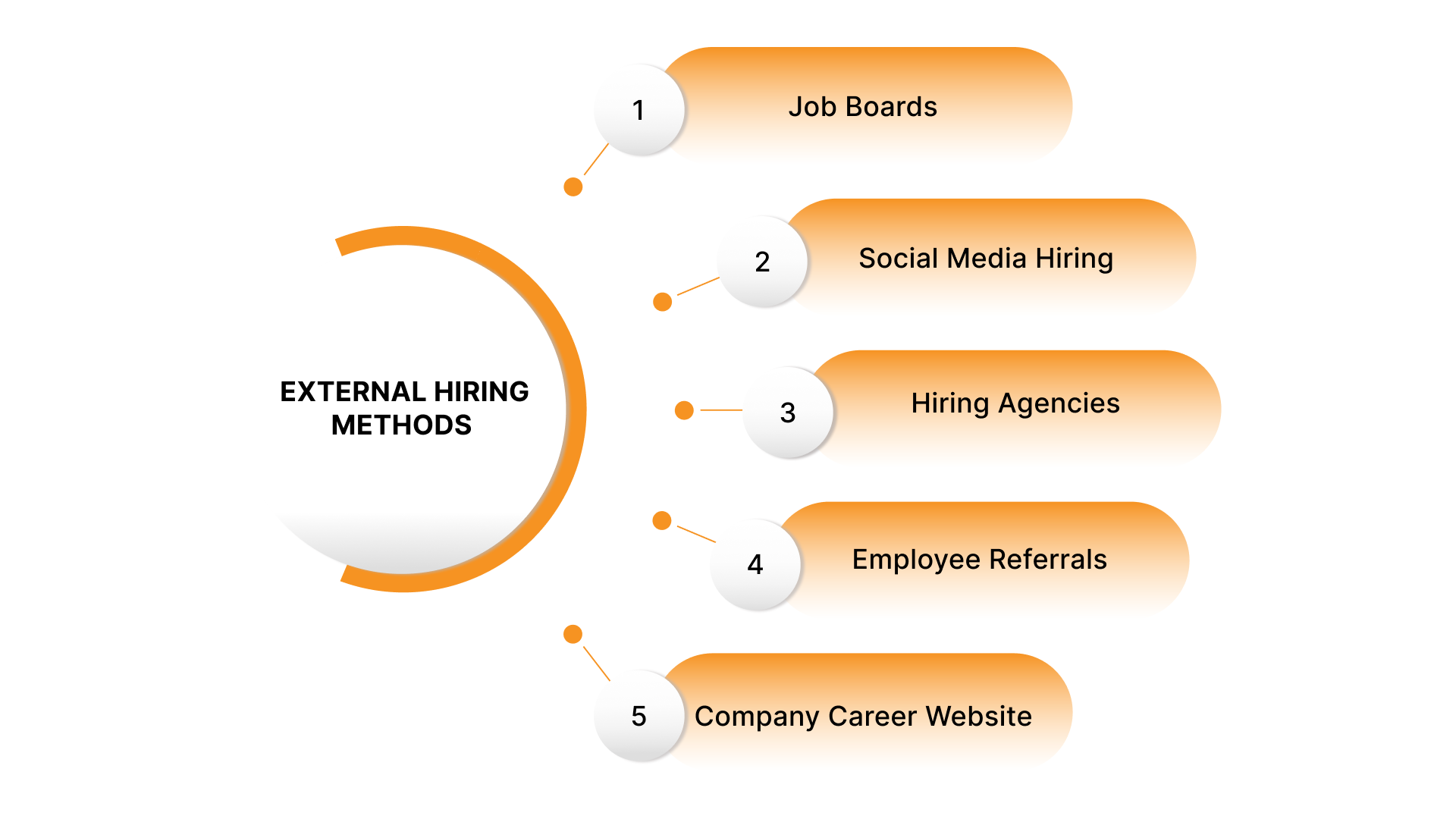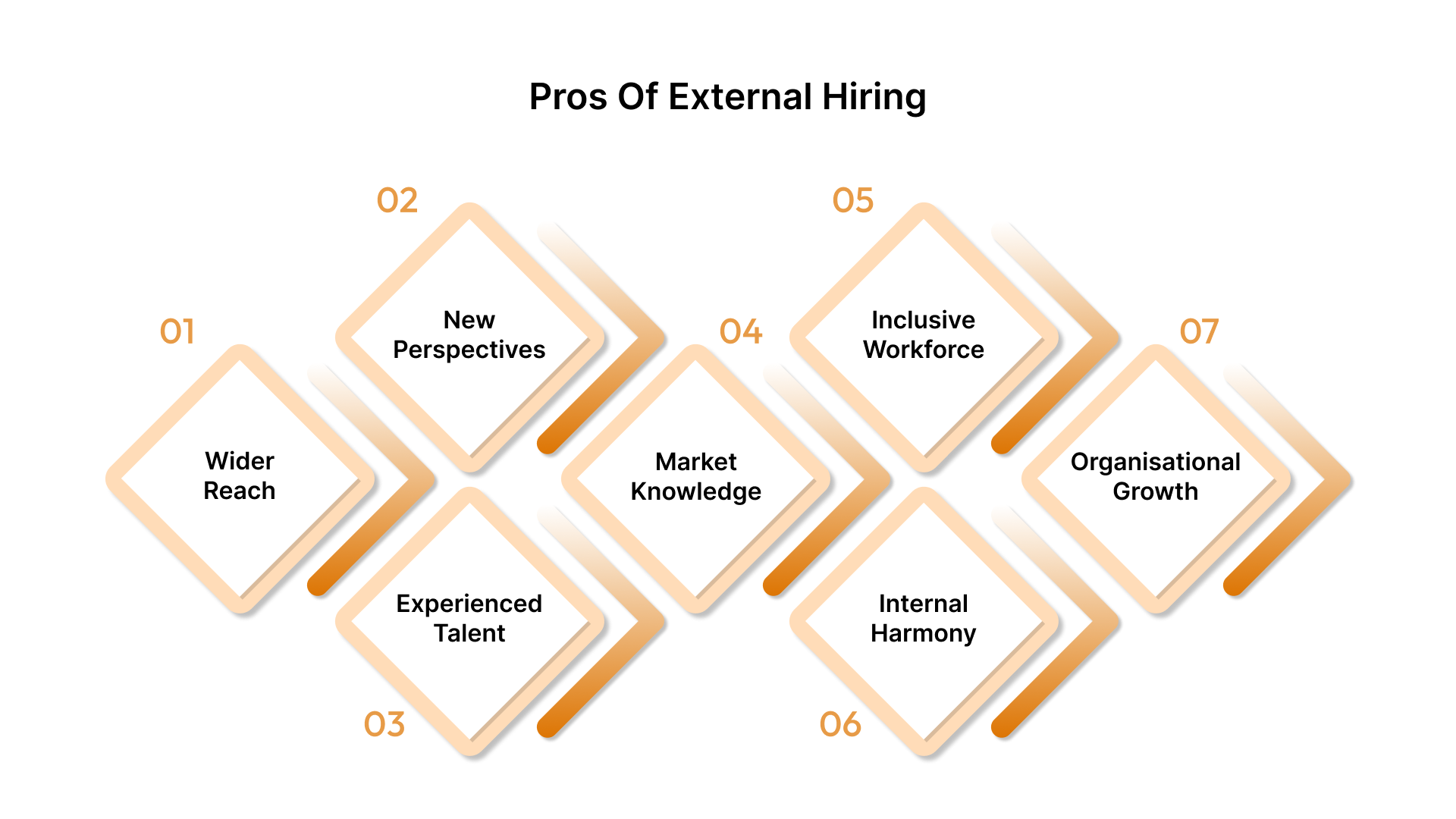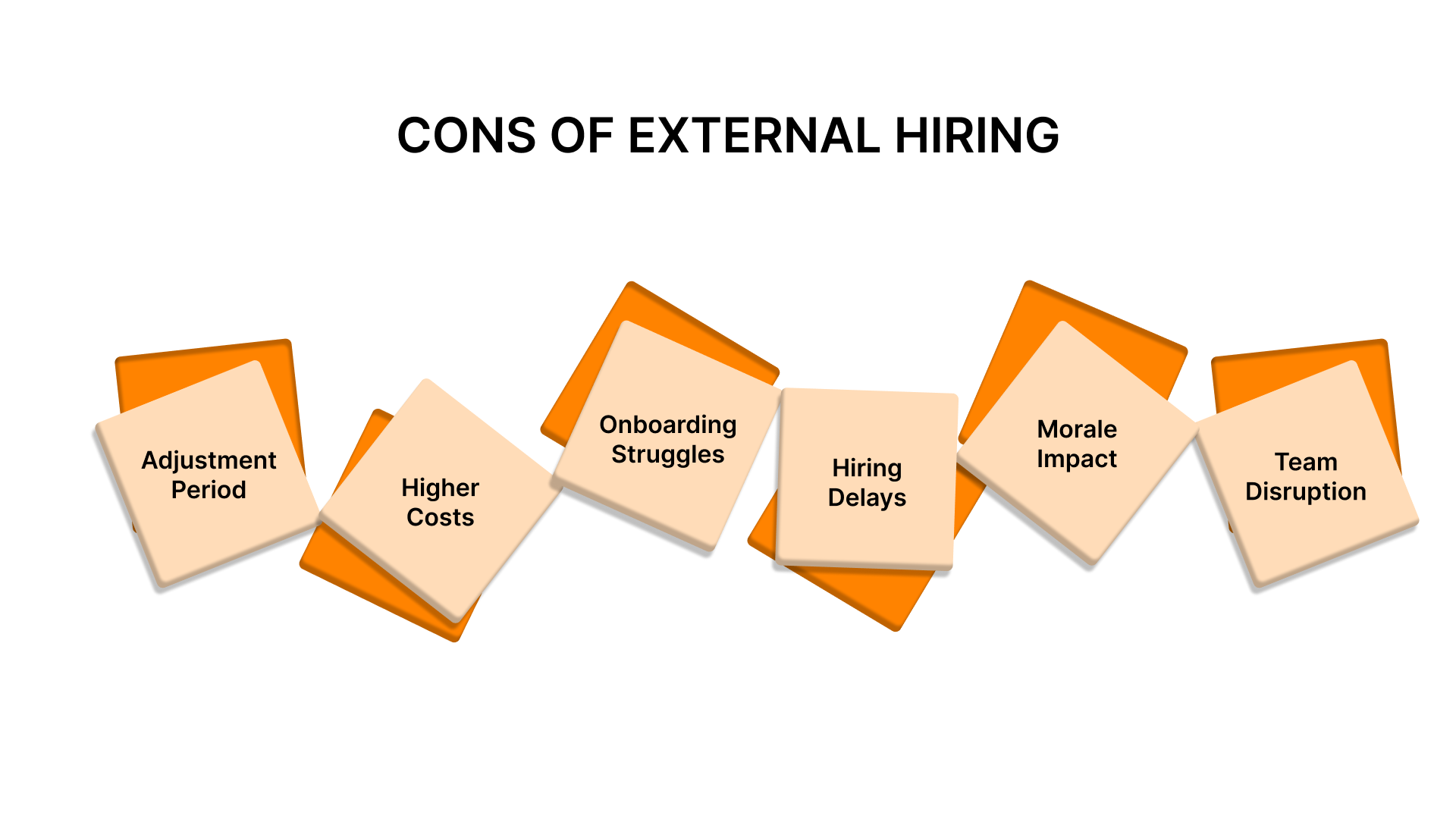External hiring has become a strategic necessity for many organisations navigating shifting workforce dynamics. The widespread disruption caused by the pandemic, coupled with ongoing attrition trends like rising employee turnover and persistent skill gaps, has prompted employers to reassess their approach to talent acquisition. In many cases, internal resources alone are no longer sufficient to meet evolving business requirements or fill skill-specific gaps.
In fact, 87% of employers successfully filled at least four out of ten roles with candidates from outside their local areas, illustrating a clear shift in hiring practices and changing nature of work.
This blog provides a comprehensive overview of external hiring, exploring its primary methods, and evaluating both, benefits and limitations. It also outlines best practices and the role of technology in building a structured, forward-looking hiring strategy.
Key Takeaways
- External hiring helps organisations tap into broader talent pools to address skill gaps, drive innovation, and improve diversity.
- Effective external hiring methods include job boards, social media, hiring agencies, and employee referrals, each offering unique benefits.
- Challenges such as longer transition periods, increased costs, and integration issues can be mitigated with a strategic hiring approach and the right partner.
- Staffing partners offer scalable hiring solutions that guarantee fast, cost-effective, and high-quality talent acquisition.
What Is External Hiring?
External hiring refers to the practice of sourcing and hiring candidates from outside the organisation. This method is typically adopted when internal options are limited or unsuitable for the role in question. It allows employers to tap into a wider talent pool and find individuals with the exact skills, experience, or qualifications required. This approach plays a vital role in maintaining a competitive and future-ready workforce.
Why Organisations Rely on External Hiring

The need for external hiring is driven by several strategic and operational factors:
- Limited Internal Talent Availability: When existing employees lack the necessary experience, certifications, or domain knowledge for a particular role.
- Access to Specialised Skills: Certain technical or leadership positions require niche expertise not commonly found within the current workforce.
- Business Expansion or Transformation: New verticals, product lines, or geographic expansions often call for talent that can hit the ground running.
- Succession Planning Gaps: In some cases, the internal pipeline may not be ready to fill senior or strategic roles, requiring external intervention.
By using external hiring, organisations access broader skills and fresh perspectives. The next step lies in understanding the various methods through which this external talent can be identified, engaged, and hired.
What Are the External Hiring Methods?

To find the right talent beyond internal teams, businesses must adopt structured and strategic methods for external hiring. These approaches vary based on role complexity, timelines, and industry-specific needs. Below are some of the most widely used external hiring methods:
1. Job Boards
Job boards offer broad access to active jobseekers across various sectors and levels.
- Widely used platforms include LinkedIn, Indeed, Naukri, and Glassdoor.
- Many job boards allow direct integration with Applicant Tracking Systems (ATS), simplifying candidate flow.
- The effectiveness of this method largely depends on the quality of the job description, such as clear, well-structured postings tend to attract stronger applicants.
- Including functional keywords and accurate role details improves visibility and targeting.
2. Social Media Hiring
Social media channels have become indispensable for engaging modern talent, particularly for brand-driven and culture-conscious organisations.
- Platforms like LinkedIn, Facebook, Instagram, and Twitter allow employers to promote openings and showcase their work environment.
- Employer branding plays a central role because authentic content and consistent tone help build credibility among prospective candidates.
- Social platforms also enable direct communication with passive candidates, many of whom may not be actively applying but are open to new opportunities.
- Digital footprint checks can also support early-stage evaluation during the screening process.
Read More: The Importance of Employer Branding in Recruitment
3. Hiring Agencies
Engaging a professional hiring agency can be especially valuable when filling niche roles or working with tight deadlines.
- Hiring partners provide access to pre-evaluated candidates and save internal teams valuable time and effort.
- They bring deep expertise in specific domains and industries, making them particularly effective for technical, senior, or confidential roles.
- For organisations seeking structured and SLA-driven hiring support within India, V3 Staffing offers scalable solutions across major business hubs, including Hyderabad, Bengaluru, Chennai, Pune, Delhi NCR, and Mumbai.
4. Employee Referrals
Referrals from current employees can often result in high-quality hires, especially when cultural fit is a priority.
- Internal recommendations tend to reflect a better understanding of role expectations and company values.
- To encourage ongoing participation, businesses typically offer structured referral incentives and regular communication around open roles.
- This method also promotes a sense of involvement and ownership within the existing team.
5. Company Career Website
An organisation’s career page is more than a job listing; it is a digital extension of its employer brand.
- Well-designed career websites serve as a direct channel for applications, especially from candidates researching potential employers.
- Including content that reflects the company’s culture, values, and career progression pathways adds authenticity and appeal.
- Incorporating SEO best practices improves visibility in search results and draws in a more relevant audience.
- Providing a clear application process and a user-friendly interface encourages candidate engagement.
Also Read: Recruiting for Cultural Fit vs. Skills: Striking the Right Balance
Each external hiring method offers unique benefits depending on the organisation’s needs, timelines, and resource availability. When applied strategically, these methods can unlock several advantages that go beyond simply filling a vacancy.
Pros of External Hiring

When planned and executed thoughtfully, external hiring brings a range of strategic and operational benefits. It enables organisations to strengthen capability, introduce new thinking, and maintain momentum in competitive markets.
1. Access to a Broader Talent Pool
Sourcing candidates externally expands the organisation’s reach beyond internal networks or known talent circles.
- Brings in professionals with varied skill sets and industry exposure
- Helps organisations identify rare or high-demand capabilities
- Supports hiring for newly created or specialised roles where internal expertise is limited
2. Bringing Fresh Ideas and Perspectives
External candidates often contribute new ways of thinking, influenced by different corporate cultures, sectors, or geographies.
- Encourages innovation by introducing diverse viewpoints
- Breaks established thinking patterns and challenges legacy systems
- Drives positive change and supports long-term adaptability
3. Qualified and Experienced Candidates
Hiring from outside the organisation enables access to individuals who have already developed expertise in similar roles or sectors.
- Reduces time spent on training and onboarding
- Ideal for leadership, technical, or project-based positions
- Allows organisations to benefit from external best practices
4. Market Insights and Staying Competitive
Professionals from outside often carry valuable knowledge about competitors, trends, and market developments.
- Contributes to informed decision-making at both operational and strategic levels
- Helps keep internal teams aligned with evolving customer and market expectations
- Supports benchmarking against external standards
5. Diversity and Inclusion
External hiring plays a key role in building diverse teams, both demographically and experientially.
- Promotes a more inclusive work environment
- Improves team performance through varied problem-solving approaches
- Contributes to stronger collaboration and broader thinking
6. Easing In-House Tension
Hiring externally for critical roles can help minimise internal competition and maintain workplace harmony.
- Avoids creating conflict among existing employees vying for the same promotion
- Brings clarity and objectivity to the selection process
- Reinforces merit-based hiring decisions
7. Growth for the Entire Organisation
The positive impact of external hiring often extends beyond the individual role being filled.
- Encourages current employees to raise performance standards
- Signals commitment to capability-building across the organisation
- Supports the development of a dynamic, forward-looking workplace culture
While external hiring offers several advantages, it is not without its challenges. Understanding these limitations is essential to making informed decisions and managing expectations across the organisation.
Cons of External Hiring

While external hiring brings valuable advantages, the challenges below can affect timelines, budgets, and internal team dynamics if not addressed thoughtfully.
1. Longer Transition Period for New Hires
New employees hired externally often require time to adjust to the organisation’s culture, processes, and expectations.
- Adaptation may take longer compared to internal hires familiar with the company’s way of working
- Cultural integration can be a gradual process, particularly in established teams
- Productivity gains may not be immediate during the settling-in period
2. Increased Costs
Hiring externally can be significantly more expensive than filling roles internally.
- Costs may include agency fees, job board subscriptions, advertising expenses, and background checks
- Additional expenditure may arise from relocation packages or external training programmes
- Hidden costs, such as time spent by hiring managers and HR, can accumulate over time
3. Training and Onboarding Challenges
External candidates typically require more comprehensive onboarding and initial training than internal hires.
- Organisations must invest time and resources to familiarise new hires with internal systems, tools, and workflows
- Temporary dips in productivity are common during the learning phase
- The effectiveness of training programmes becomes critical to long-term retention and performance
4. Time-Consuming Hiring Process
The overall external hiring cycle can be lengthy and resource-intensive, particularly for specialised or senior roles.
- Each stage, such as sourcing, screening, interviewing, and vetting, requires careful planning and execution
- Delays in hiring may impact team workloads and project timelines
- Multiple stakeholders may be involved, adding complexity to coordination and decision-making
5. Impact on Employee Morale
Internal candidates who are passed over in favour of external hires may feel overlooked or undervalued.
- This can lead to reduced engagement or a sense of stagnation among existing team members
- The perception of missed internal opportunities can negatively affect trust in leadership
- Transparent communication becomes essential to manage expectations and maintain motivation
6. Adjustment Challenges for Existing Employees
The integration of external hires, especially in management or leadership roles, may initially disrupt team cohesion.
- Teams may require time to adjust to new working styles or leadership approaches
- Shifts in responsibilities or reporting lines can lead to uncertainty or resistance
- Careful onboarding and alignment are needed to maintain stability and collaboration
Facing challenges with hiring? V3 Staffing’s solutions improve your recruitment process to bridge demand-supply gaps, reduce time-to-hire, and guarantee role-to-talent precision.
Best Practices for External Hiring
To guarantee external hiring efforts lead to lasting results, organisations must focus on process clarity, candidate experience, and cultural alignment. Below are some of the most effective practices:
- Write Clear and Compelling Job Descriptions: Define responsibilities, skills, and expectations clearly. Use professional language that aligns with your company’s values to attract suitable candidates.
- Utilise Multiple Hiring Channels: Use a mix of job boards, social media, referrals, and direct applications. Match sourcing methods to the role’s requirements to improve reach and relevance.
- Simplify the Application and Interview Process: Keep application forms concise and interview stages consistent. A faster process helps retain candidate interest and improves the overall experience.
- Conduct Thorough Screening and Assess Cultural Fit: Go beyond technical skills by evaluating long-term alignment with organisational values. Tools like ATS and structured interviews can support fair assessments.
- Maintain Timely Communication and Feedback: Keep candidates informed at each stage. Offering prompt feedback strengthens your employer brand and encourages future engagement.
- Focus on Cultural Integration from Day One: Support new hires with clear onboarding, mentoring, and early check-ins. This promotes smoother adjustment and long-term retention.
Also Read: Impact & Importance to Boost the Candidate Experience
While structured hiring practices lay the foundation for successful outcomes, the role of technology has become increasingly vital in managing both scale and complexity. Integrating digital tools can significantly improve accuracy, speed, and consistency throughout the external hiring process.
ogy Can Improve External Hiring
Technology plays a critical role in addressing the scale, speed, and complexity of external hiring. From automating administrative tasks to improving candidate assessment, Digital tools have changed how organisations find and hire talent, making the process easier and faster, especially for large-scale hiring.
| Technology | Application in Hiring |
| Applicant Tracking Systems (ATS) | Automates job postings, tracks applicants across stages, and centralises candidate communication. |
| AI and Automation Tools | Supports CV screening, matches candidates to roles, and uses predictive analytics to assess fit and retention potential. |
| Digital Interviewing Platforms | Enables virtual interviews and online assessments, supporting distant hiring and reducing logistical barriers. |
While technology has improved many aspects of external hiring, organisations still face challenges that require deep domain expertise and contextual understanding. This is where experienced hiring partners play a pivotal role in bridging gaps and ensuring consistent, high-quality outcomes.
Struggling with tech integration in hiring? V3 Staffing combines the power of technology with human expertise to deliver effortless, effective results.
How V3 Staffing Supports External Hiring
Organisations navigating external hiring often encounter challenges related to cost, speed, and candidate integration. V3 Staffing addresses these gaps with hiring solutions customised to India’s evolving business landscape.
With established delivery hubs in Hyderabad, Bengaluru, Chennai, Pune, Delhi NCR, and Mumbai, V3 Staffing supports both Indian and international firms through high-touch, SLA-driven hiring models.
Core hiring services include:
- Permanent Recruitment
- IT Staffing
- Executive Search for leadership hiring
- RPO and contract workforce support for project-based or embedded hiring
Key advantages of working with V3 Staffing:
- Domain-specific hiring experts across IT, BFSI, engineering, and shared services
- Flexible sourcing models aligned to business scale and urgency
- End-to-end lifecycle support, from role scoping to onboarding
- SLA-based delivery with clear accountability, timelines, and reporting
- Regional coverage, including Tier-II sourcing via dedicated teams
- Structured screening and offer-to-join management to reduce attrition and mismatches
Whether addressing time-to-hire, quality concerns, or regional hiring needs, V3 Staffing helps simplify external hiring with consistency and professionalism across India.
Conclusion
External hiring plays a critical role in helping organisations access new capabilities, improve diversity, and respond to changing market demands. While it may involve added time and cost, the long-term benefits from accessing broader talent pools to securing specialised skills can significantly strengthen an organisation’s workforce.
V3 Staffing supports businesses in managing these complexities through structured hiring services customised to India’s evolving landscape. We assure accuracy, speed, and regional alignment across every engagement.
Looking to strengthen your workforce with precision and speed? Contact us to explore hiring solutions that align with your business goals.
FAQs
1. Why is external hiring better?
External hiring allows organisations to access a broader talent pool, gain fresh perspectives, and secure specialised skills that may not be available internally. It helps meet evolving business needs and promotes innovation.
2. What is the biggest advantage of external recruiting?
The biggest advantage is the ability to bring in qualified candidates with specific skills, expertise, and fresh ideas, which can drive innovation, improve competitiveness, and fill critical skill gaps.
3. What are the limitations of external sources of recruitment?
External recruitment can be costly, time-consuming, and may result in longer onboarding periods. Additionally, it can impact employee morale if internal candidates are overlooked, and the integration of new hires may disrupt existing team dynamics.




